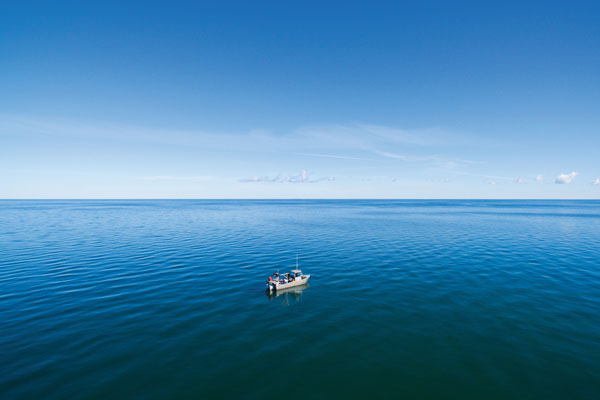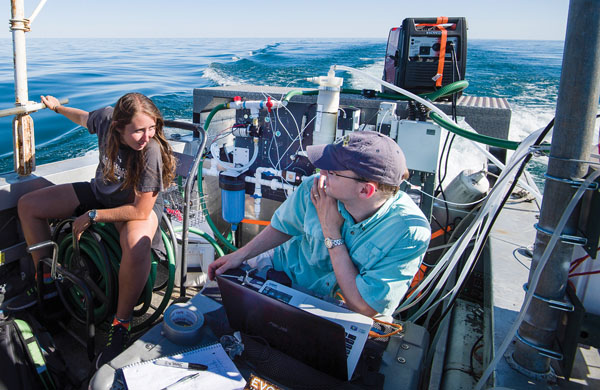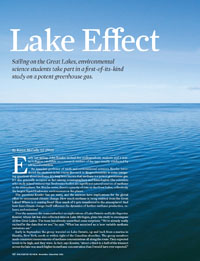Features
 UNDERCURRENTS: Freshwater bodies such as Lake Ontario are major natural sources of methane. Last summer, a professor and six
students set out onto the lake to take some measurements. They conducted similar research on Lake Superior in October, as
part of a study they hope will encompass all five Great Lakes. (Photo: Keith Walters for Rochester Review)
UNDERCURRENTS: Freshwater bodies such as Lake Ontario are major natural sources of methane. Last summer, a professor and six
students set out onto the lake to take some measurements. They conducted similar research on Lake Superior in October, as
part of a study they hope will encompass all five Great Lakes. (Photo: Keith Walters for Rochester Review)Early last spring, John Kessler invited five undergraduate students and a master’s degree candidate on a research venture of the type usually conducted by advanced scientists.
 PRIME PUMP: Kessler’s team designed instrumentation that Eisenstadt, Riddell-Young, and Kessler used last summer to provide continuous measurements of methane levels in Lake Ontario. Kessler was awarded a National Science Foundation grant that enabled the group to test the equipment on Lake Superior in the fall. (Photo: Adam Fenster)
PRIME PUMP: Kessler’s team designed instrumentation that Eisenstadt, Riddell-Young, and Kessler used last summer to provide continuous measurements of methane levels in Lake Ontario. Kessler was awarded a National Science Foundation grant that enabled the group to test the equipment on Lake Superior in the fall. (Photo: Adam Fenster)Meet the Team
John Kessler
Associate Professor of Earth and Environmental Sciences
John Kessler’s principal interest is the dynamics of methane in oceans. He joined Rochester’s faculty in 2012 from Texas A&M University, where he had conducted headline-grabbing research on the aftereffects of the Deep Water Horizon oil spill in the Gulf of Mexico. The spill, he said, provided him “a natural laboratory” to answer some basic questions, such as, “What happens when a large release of methane is emitted to the ocean. Where does it go? What is its ultimate fate?” He discovered that within months of the spill, methane levels had returned to pre-disaster levels as rapidly reproducing microorganisms devoured more than 200,000 metric tons of the gas.
Kessler cautions against the hope that nature may have provided humans with a microscopic cleaning staff. “These organisms eat incredibly quickly,” he says. “It can have some adverse effects on the environment, like the removal of oxygen from the waters, and potentially, an acidification effect as well.”
The research he and his group of mostly undergraduates are conducting this year is an initial phase of what he hopes will be an extensive investigation. They’ll be measuring the concentrations of methane in each of the Great Lakes at varying points in space and time. That data, he says, will lead to some hypotheses to address larger unknowns about the source of the methane and the dynamics of its release and impacts.
Widely recognized on the River Campus as an inspiring teacher, Kessler won the Goergen Award for Excellence in Undergraduate Teaching in 2015.
Amy Eisenstadt ’16 Brooklyn, New York BS, geological sciences; pursuing MS degree
Sawyer Johnson ’16 Los Angeles Major: environmental science
Colin McCormack ’16 Randolph, New Jersey Major: environmental science
Benjamin Riddell-Young ’18 Slingerlands, New York Major: environmental science
Nicola Wiseman ’18 Waterford, Connecticut Major: environmental science
Eric Yarmoff ’16, ’17 (T5) Maisons Laffitte, France Major: geological sciences
An associate professor of earth and environmental sciences, Kessler introduced the students in his course Research in Biogeochemistry to some intriguing questions about methane. It’s long been known that methane is a potent greenhouse gas. It’s also generally accepted as fact among oceanographers and limnologists (the scientists who study inland waters) that freshwater bodies are significant natural sources of methane to the atmosphere. Yet, Kessler notes, there’s a paucity of data on the Great Lakes, collectively the largest liquid freshwater environment on the planet.
The questions Kessler has are many, and the answers have implications for the global effort to understand climate change. How much methane is being emitted from the Great Lakes? Where is it coming from? How much of it gets transferred to the atmosphere? And how does climate change itself influence the dynamics of further methane production, release, and emission?
Over the summer, the team embarked on explorations of Lake Ontario and Lake Superior. Kessler, whose lab has also collected data on Lake Michigan, plans his study to encompass all five Great Lakes. The team has already unearthed some surprises. “We’re already really excited by the data that we see,” he says. “What has surprised us is how variable methane emissions are.”
Early in September, the group traveled on Lake Ontario, up and back from a marina in Hamlin, New York, north to within sight of the Canadian shoreline. The group members made consistent measurements of methane concentrations all along the route. They expected levels to be high, and they were. In fact, says Kessler, “about a third to a half of the transect across the lake was much higher in methane concentration than I would have ever expected.”
A Closer Look at Methane
Why study methane?
A much more efficient heat trapper than carbon dioxide, methane is widely considered the second most important greenhouse gas among those who study and combat global climate change.
Its sources are both natural and human-derived, and it “accounts for a substantial fraction of the manmade warming in the atmosphere that we’re experiencing right now,” says John Kessler, associate professor of earth and environmental sciences.
Why study methane in the Great Lakes?
Oceans, which have been studied extensively, are relatively minor sources of methane in the atmosphere. Fresh water environments are significant sources, and, according to Kessler, there’s been surprisingly little research on them. The Great Lakes collectively form the largest body of fresh water on the planet—an estimated six quadrillion gallons.
What do we want to know about methane?
Says Kessler: “Number one: we want to be able to map how much methane is out there. What are its fluxes, its emission rates to the atmosphere? What’s the distribution across all of the Great Lakes?”
The second goal is to understand its sources. Kessler says there’s a “traditional view,” that methane is produced in little-to-no-oxygen environments, such as deep in the sediment at the bottom of lakes and oceans. But scientists have recently found that methane can be produced in lakes and oceans where oxygen is abundant. “That process is not well understood,” he says. Among his goals is “trying to figure out how this specific environment is producing methane.”
Methane: A moving target
Although Kessler and his team are focused on methane, they won’t be considering it in isolation. The key to climate change is in the interaction of gases with one another, and the dynamics of that interaction are in constant flux. Certain processes add to the atmospheric concentration of greenhouse gases; other processes work to remove them. Many of those dynamics are not well understood.
“I think that one of the things that motivates a lot of us to do this research is [to get] a better predictive understanding of how the planet functions,” Kessler says. That entails answering some complex questions. As the planet warms, or as it gets wetter or dryer, how will those changes affect the future interactions among gases? Will natural emissions change? If so, how?
But when the team repeated that same journey about a month later, much of that methane was gone. The levels were “only a quarter to a third of what they were,” he says. “What’s causing those massive changes, we don’t know.”
The course began last spring semester, as the students each developed individual research plans in which they would examine some aspect of methane cycling in the Great Lakes and nearby waterways. They prepared formal research proposals, outlining hypotheses and experiments as if they were applying for a National Science Foundation grant. At the end of the semester, the students conducted mock panel reviews.
They also worked together to develop their own equipment to take measurements. The traditional method is to collect vials of water and bring them back to the lab for analysis. The students did some of this, but as Kessler says, “the problem with doing it that way is that there are really only so many vials that we can fill up in a day and physically bring back to the lab.”
They developed a means of vacuum gas extraction in which water is pumped continuously through a gas-permeable membrane, while a vacuum removes dissolved gases from the water stream. The extracted gases are then pumped into a spectrometer where they can be analyzed in real time. They used that equipment, as well as traditional methods, to collect and analyze data.
Over the summer, not everything went as they had hoped. The group had to cancel a few of their excursions. It was unusually hot and dry throughout July and August—except on many of the days Kessler planned trips. “I was joking that I could single-handedly end the drought in western New York just by scheduling more of our trips on Lake Ontario,” he quips, referring to the excessive rain and winds that befell the region on several of the days the students were to collect data.
Nonetheless, their efforts paid off. They’d begun with a small budget: a $10,000 Pump Primer grant from Arts, Sciences & Engineering, and some additional monies from the Elizabeth Wright Dunbar fund, which supports the Department of Earth and Environmental Sciences. Based on the seed data the group collected last summer and the instrument prototypes they developed, the National Science Foundation awarded Kessler a two-year grant that enabled them to spend a week in October collecting data on Lake Superior in a state-of-the-art, fully staffed NSF research vessel.
Nicola Wiseman ’18, an environmental science major from Waterford, Connecticut, says the voyage was galvanizing. “The crew of the ship was wonderful. We accomplished a lot in terms of data collection, so we’re all thrilled,” she says.
The students divided into day and night shifts, taking surface methane samples every hour while their continuous gas extraction equipment ran without interruption. The fully equipped vessel made it possible for them to conduct some quick data analyses and prepare the data for a full analysis back in Kessler’s lab. Wiseman is looking forward to that process, as well as to continuing the research for the long haul.
“I’m hoping to continue my involvement in this research even after the class has ended,” she says, noting that the NSF grant also funds a second trip to Lake Superior, and potentially other Great Lakes, this coming summer. “This trip really made me realize that doing research is what I want to do for the rest of my life, and I’m incredibly excited to see where we go from here.”
Eric Yarmoff ’17, an environmental science major who was born in Princeton, New Jersey, and raised in France, says the course is teaching him a great deal not only about science, but also about the life of a scientist conducting field research.
“I’ve learned plenty about the geochemical methane cycle and the processes influencing it,” he says. “But more importantly, I’ve learned quite a bit about the research process itself: securing funding, planning trips, organizing teams for research excursions, and how to be flexible in the face of unpredictable situations.”
Kessler revels in surprise and uncertainty, and delights in furthering a similar spirit of adventure among his students. For this group, that spirit seems to have come naturally.
“The success of an endeavor like this largely hinges on the quality of the students,” he says. On Lake Superior, the group hit some rough weather—the kind that can knock scientists out for hours at a time.
“Everybody got seasick,” Kessler says. “But we kept working, and it was awesome.”
Includes additional reporting by Peter Iglinski, Jim Mandelaro, and Matthew Mann.

